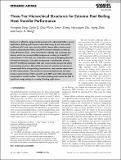Three‐Tier Hierarchical Structures for Extreme Pool Boiling Heat Transfer Performance
Author(s)
Song, Youngsup; Díaz‐Marín, Carlos D; Zhang, Lenan; Cha, Hyeongyun; Zhao, Yajing; Wang, Evelyn N; ... Show more Show less
DownloadPublished version (2.382Mb)
Publisher with Creative Commons License
Publisher with Creative Commons License
Creative Commons Attribution
Terms of use
Metadata
Show full item recordAbstract
Boiling is an effective energy-transfer process with substantial utility in energy applications. Boiling performance is described mainly by the heat-transfer coefficient (HTC) and critical heat flux (CHF). Recent efforts for the simultaneous enhancement of HTC and CHF have been limited by an intrinsic trade-off between them-HTC enhancement requires high nucleation-site density, which can increase bubble coalescence resulting in limited CHF enhancement. In this work, this trade-off is overcome by designing three-tier hierarchical structures. The bubble coalescence is minimized to enhance the CHF by defining nucleation sites with microcavities interspersed within hemi-wicking structures. Meanwhile, the reduced nucleation-site density is compensated for by incorporating nanostructures that promote evaporation for HTC enhancement. The hierarchical structures demonstrate the simultaneous enhancement of HTC and CHF up to 389% and 138%, respectively, compared to a smooth surface. This extreme boiling performance can lead to significant energy savings in a variety of boiling applications.
Date issued
2022-08Department
Massachusetts Institute of Technology. Department of Mechanical EngineeringJournal
Advanced Materials
Publisher
Wiley
Citation
Song, Youngsup, Díaz‐Marín, Carlos D, Zhang, Lenan, Cha, Hyeongyun, Zhao, Yajing et al. 2022. "Three‐Tier Hierarchical Structures for Extreme Pool Boiling Heat Transfer Performance." Advanced Materials, 34 (32).
Version: Final published version